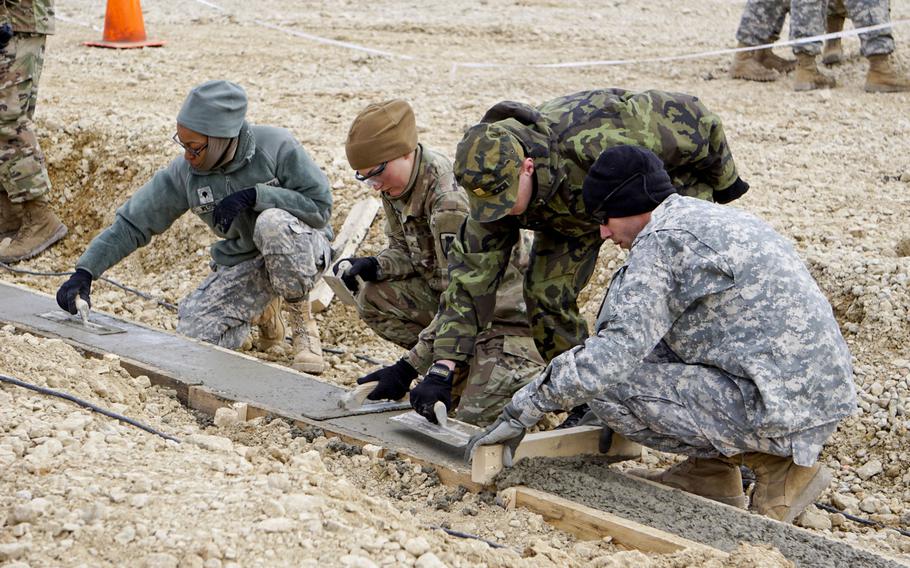
Texas National Guard soldiers from the 236th Engineer Battalion erect a parachute landing fall complex at the Joint Multinational Readiness Center training area in Hohenfels, Germany April 5, 2017. U.S. Army Europe is increasingly utilizing engineer reserve and guard units on its projects across Europe. (Karen Sampson/U.S. Army)
WIESBADEN, Germany — With construction underway on more than 600 projects worth around $4 billion across U.S. Army Europe’s purview, the Wiesbaden-based command is employing Army Reserve and National Guard construction units more than ever before.
In testimony before a Senate appropriations subcommittee last week, Gen. Curtis Scaparrotti, commander of U.S. European Command and NATO’s Supreme Allied Commander, said that the construction and improvement of facilities for storage and deployment capabilities was his “highest priority” as allied forces look to counter Russian forces on their eastern flank.
Since Russia’s takeover of the Crimean peninsula in 2014, USAREUR and NATO have been investing billions of dollars in the expansion of logistical infrastructure for training and deployment readiness as part of USAREUR commander Lt. Gen. Ben Hodges’ emphasis on the command being ready to “fight tonight” in the event of a crisis.
The heavy reliance on Reserve and National Guard units in the construction effort is a consequence of the fact that those components contain many vital logistical and support units lacking in the regular force, USAREUR’s top reserve officer said.
“If you look at the overall total army, most of the logistics are found in the reserve component — about 60 percent of your engineer assets, a lot of assets have been moved there because it’s cheaper,” said Brig. Gen. Phillip Jolly, head of the command’s Army Reserve Engagement Cell. “We’re saving the taxpayer money, but we still have a real-world mission over here.”
The increased use of the reserve components is also due to the existence of ARECs, which act within Army regional commands such as USAREUR as a liaison between the components.
“The growth that we’ve seen, it really stems from the fact we’ve gotten better at being able to bring in National Guard and Reserve to do their training with us,” Capt. Christopher Bradley, a spokesman for the Joint Multinational Training Center in Hohenfels.
The Hohenfels-based troop construction project will utilize more than 1,000 engineering and construction soldiers this year, largely from the U.S. Army Reserve and National Guard, who will come over for their required yearly annual training. It’s something that works to the mutual benefit of USAREUR and the rotational units, said Maj. Hector Mojica, head of the program.
“Most of the time they don’t have the size of projects that we have here back at their home station — they’re limited on the projects they can work and can only train a squad or platoon at the most. Here they get to train the whole unit,” he said. “It’s a real-life experience here, and also they get to train on their deployment and redeployment tasks.”
Currently the major project underway at Hohenfels training area is a short-takeoff landing strip, or STOL, for unmanned aerial vehicles scheduled for completion later this year. Other projects include parachute landing practice pits and transforming an existing building into a simulated consulate for training on a Benghazi-type evacuation scenario, Mojica said.
Soldiers with the 236th Engineer Company of the Texas Army National Guard recently wrapped up a three-week rotation at the site, working mainly on the pits and the landing strip. While stateside annual training typically lasts two weeks, units participating at Hohenfels are required to stay three, with some advance party soldiers staying nearly a month in all.
“It’s far more beneficial than doing our two-week annual training back home,” Sgt. 1st Class Ben Guenther, a construction supervisor with the 236th Engineer Co., said. “We get an extra week with the troops, to train them up. The opportunity to identify strengths and weaknesses of the soldiers and see how they operate in different situations for us as leaders is very valuable.”
In addition to the construction at Hohenfels, Jolly said reserve units are building ranges in Romania and Poland which will allow rotational units to maintain their basic vehicle gunnery skills while deployed to Europe.
“They’re building readiness and also building capabilities for USAREUR,” he said. “By September, we’re going to have active ranges that can support units coming over. It’s a win-win-win situation.”
stoutamire.dan@stripes.com Twitter: @DKS_Stripes